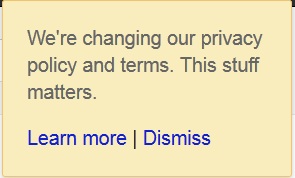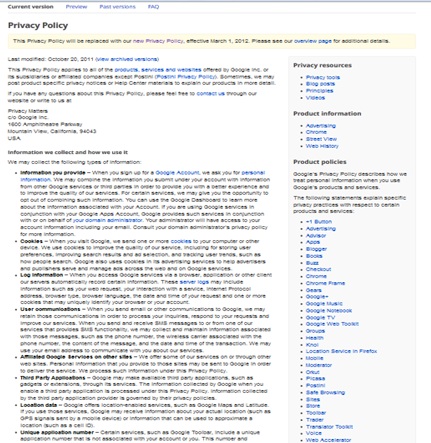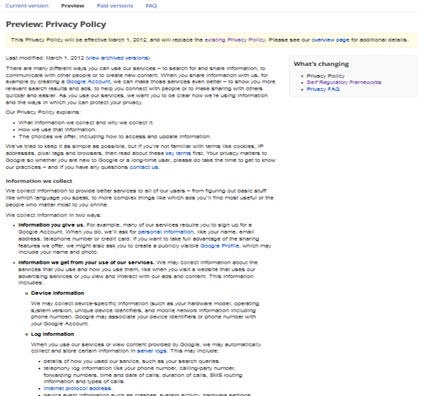Google Privacy Policy Updates ‑ A Web Geek's Perspective
Google announces that it will be passing user information across product lines to move forward master plans to create a more unified user experience. Nerdy commentary is provided.

(Their drawing, not mine.)
On Tuesday, Google announced it will be changing its current privacy policy and Terms of Service, effective March 1. Google’s made a bit of a deal out of this – you’ve probably seen the links at the middle or bottom of the Google home page or the yellow box:

(It’s nice to see Google making such a “buzz” about changes to user privacy;)
This is another notable display of transparency, what with Google announcing the changes over a month in advance and doing its best to publicize them. And let’s not forget Google’s Transparency Report, which shows figures and compliance rates on government User Data Requests and Content Removal Requests – an incredibly interesting report on international privacy, government, and freedom of speech that I could discuss for hours. But to get back to the Google’s Privacy policy and TOS, Google has clearly broken the bank on the latest computer animation technology to provide a video explaining the changes. The new policy utilizes the simplest language lawyers are capable of, and does seem more user-friendly. Clearly, Google is at least concerned with other people’s concerns with privacy, and is doing its best to pre-empt the inevitable backlash and curb mass hysteria by being clear and transparent.

VS.

But is anything really changing? At first glance, the new policy and the current main policy look very similar, albeit one uses more accessible language. The language change and additional explanations of data collection methods and geeky terminology actually helps the new policy seem a lot less creepy. The real difference is that Google will be replacing over 60 additional privacy policy statements (that huge list on the right) into a singular master Privacy Policy for (nearly) all of its products. According to Google, they aim to “create one beautifully simple, intuitive user experience across Google… In short, we can treat you as a single user across all our products.”
That’s why Google will now share user data amongst its products such as YouTube, Maps, Gmail, and even Android. That’s where the creepy factor rears it’s head again. Not every one is keen on the possibility of their e-mails, chats, video history, search history, and Maps usage to be tied together to their identity. For those concerned about their privacy, I highly recommend Google’s consumer education center on Internet privacy and security as well as Google’s center of various privacy control tools.
The positive for consumers is that sharing of data really should result in some really cool functionality enhancements. Overall, Google is getting to know you better, and this should result in more relevant search results and recomendations and better predictive features for autcorrect, voice recognition, and the like. According to Google, they “can provide reminders that you’re going to be late for a meeting based on your location, your calendar and an understanding of what the traffic is like that day. Or ensure that our spelling suggestions, even for your friends’ names, are accurate because you’ve typed them before.” Not too shabby.
But the bottom line is… well, the bottom line. A better user experience naturally equates to greater market share. Perhaps more important is that all of this data will drastically improve Google’s ability to serve relevant ads. And more relevant ads means more ad clicks. And we know what that mean$.
As an Internet marketer, I’d be lying if I didn’t tell you I was absolutely fascinated by the unprecedented ability to combine, with anonymity, consumer behavior data such as video viewing tendencies, search history, common topics of discussion (in email and chat), engagement levels for various subject matters (via email and site bounce rate, time on site, video viewing time, etc.), and geo-location. Serving a man an ad for a flower store using a picture of orchids located on the way to his dates’ house right after his calendar reminds him of his date might be weird, but it’s still hella intriguing to this nerd.
As an SEO, I can’t help but notice there will be more data than ever to assist advertisers, but SEOs, webmasters, and others dependent on Google Analytics are not provided with such luxuries. In fact, the move to pass more data across Google properties works best if more folks are logged in – and you can bet Google will continue to encourage sign-ups and logged in usage. Thus, we can continue to see keyword referral data for organic visits become less useful as (not provided) numbers continue their ascent. Perhaps the (not provided) move really was to make web marketers more relient on AdWords. I tend to see it more as a PR move – a symbolic gesture to watchdogs and concerned consumers that Google really cares about privacy – so that Google might get less flack as it changes privacy policies in order to synergize its empire of advertising real estate. It might be a meaningless gesture since users identities have always been seperate from their keyword data, but PR does stand for perception of reality, right?
Speaking of PR, it will certainly be interesting to see how all this privacy stuff plays out in the public arena. What are your sentiments, readers?


